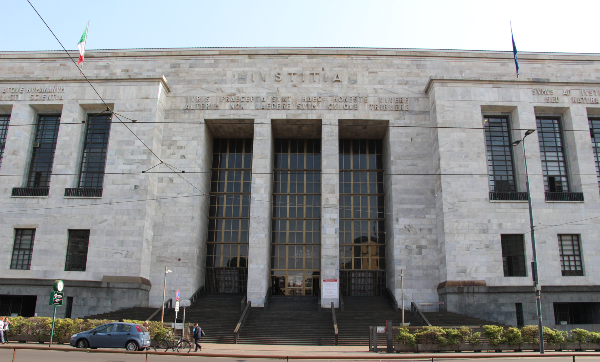The programme called Progetti di ricerca di Rilevante Interesse Nazionale [ITA] (PRIN) is managed by the Italian Ministry of University and Research. Its goal is to fund public research projects to support the national research system, strengthen interactions between universities and research organisations as outlined in the National Recovery and Resilience Plan (NRRP) and promote Italian participation in the European Framework Programme for Research and Innovation initiatives.

PI: Valeria Maggian
Duration: 30/11/2023 - 29/11/2025
Budget: € 102.961,00
CUP: H53D23008420001
Project code: P2022R248L
Despite the reduction in differences between men and women in several dimensions of social and economic life, gender gaps are still a widespread phenomenon around the world. Although in many developed countries on average girls outperform boys in high school and college, gender gaps in employment and careers are still sizeable and emerge since the very first years of job, with societies failing to reap the returns from their investment in human capital.
Our project intends to investigate the roots of gender inequalities documented in labor market outcomes starting from the early steps of career. Through the lens of cooperative and non-cooperative game theory we will investigate how the working environment might differently attract men and women and influence their behavioral reactions depending on its competitive, cooperative, and fair characteristics. In addition we will focus on the early gender gap unemployment and earnings and aims at identifying unexplored supply-related factors that may contribute to its emergence, such as differences in “soft skills” and in the ability to trade off exploration and exploitation in environments characterized by uncertainty and the possibility to face losses. Finally, as gender quotas are often called for as a solution to restore gender equality, particularly at the top of organizations, we will measure support for this policy through a survey addressed to those individuals most affected by it, namely managers.
We will adopt an interdisciplinary modus operandi that will combine knowledge from economics, sociology and psychology. By providing survey evidence using real and more heterogeneous subjects in combination with data collected in the lab, we will produce more convincing inference of the determinants of the gender gap, allowing to draw more credible policy recommendations to curb the suboptimal patterns that we observe, so to move towards a more efficient, gender equal economy and society.

PI: Francesco Lancia
Duration: 30/11/2023 - 29/11/2025
Budget: € 32.666,00
CUP: H53D23008400001
Project code: P2022L7T42
We study the role of political economy frictions in the formation and coordination of environmental governance.
In the first part of the project, we consider the role of electoral constraints on legislators’ choices on issues concerning environmental governance.
In the second part, we examine how the heterogeneity of countries, in terms of political institutions and interests in environmental protection, can hinder the coordination of their national environmental policies. The ultimate goal of this project is to provide a better understanding of how democratic institutions can effectively tackle current environmental challenges.

PI: Monica Billio
Duration: 30/11/2023 - 29/11/2025
Budget: € 112.112,00
CUP: H53D23008390001
Project code: P2022HTXXM
“ESG investing” and “sustainable finance” refer to the incorporation of environmental (E), social (S), and governance (G) issues into investors’ decisions, a fast-growing share of capital markets. This has prompted regulators, investors, and firms to integrate ESG into their decision-making. The academic and policy debate has spawned new theoretical research and prompted the analysis of new data capturing the many components of sustainability. The common finance theme is that measurable ESG characteristics affect decisions both by executives and investors. For expositional reasons, we divide our projects into those focused on ESG characteristics, on investor challenges, and on outcomes and performance—with the three parts being tightly connected.
ESG ratings have become key data—despite persistent rating disagreement. A first project will address ESG rating disagreement by offering methodology for rating construction, quantifying managerial incentives and defining marginal rates of substitutions between E, S and G pillars. Another project will use principal component analysis and machine learning to synthetize E, S, and G metrics, with the goal of identifying the empirical common determinants of E, S, and G ratings. A key aspect of these projects—and a thread connecting all projects in this proposal—is the construction of a comprehensive ESG database that incorporates high-quality, granular and long time series data from multiple data providers, both on corporate actions and ESG ratings, globally.
Regulatory concerns exist about whether investors can reliably identify the sustainability characteristics of financial securities. Evidence suggests that both institutional and retail investors are subject to greenwashing. In this part of the research proposal, we address taxes as the likely most significant but least public component of social performance of a firm. Moreover, this project will analyze whether and how firms opportunistically take least-costly actions, whether greenwashing is successful, and whether sustainability-minded investors are able to detect strategic behavior.
A key component of sustainability is investor stewardship. In one line of investigation we will analyze board turnover induced by shareholder activism. We analyze how and why investors target individual directors, the determinants of investor success in board renewal, and effects on board skills. A second line of investigation will focus on shareholder voting. A large literature assumes that shareholders vote differently if they have access to different information, with our focus being those differences. We analyze trading around shareholder meetings using proprietary position-level daily data of one of the world’s largest asset managers. To our knowledge, no prior work addresses whether and how investors use ESG data for their micro trading decisions around shareholder votes.

PI: Sara De Vido
Duration: 30/11/2023 - 29/11/2025
Budget: € 80.010,00
CUP: H53D23010800001
Project code: P20225JRCM
The circular economy is a paradigm shift that intends to combine new business models and digital infrastructure for reaching sustainability in our society (“SDCircEcon”: a Sustainable Digital Circular Economy). The core idea of the project is to transpose to the legal level the human-centred approach that is being pursued for the development of new technologies. Therefore, it is necessary to orient the SDCircEcon towards the human needs in term of wellbeing of individuals, empowering their role as citizens, also exploiting the potentiality of digital technologies. In the project’s vision, this means that humans as citizens - not merely as consumers of the digital age - should become the reference for the legal rules governing the transition to the SDCircEcon. This perspective is in line with the goals promoted by the EU legislator with reference to this research cluster: “the Union must ensure that all industrial players, and society at large, can benefit from advanced and clean technologies and digitalization. Developing technologies alone will not suffice. A societal understanding of these technologies and evolutions is crucial for engaging end users and generating behavioral change” (Council Decision (EU) 2021/764, Cluster 'Digital, Industry and Space', I/39).
Furthermore, as the Commission declared in its political agenda, 'in the world of tomorrow, if we want to be the master of our own destiny, confident in our means, value and choices, we must rely on digitally empowered and capable citizens' (Communication '2030 Digital Compass', COM(2021)118 final). This is perfectly matched by the Italian National Research Plan: “the individual is the first actor and beneficiary of the paradigm shift resulting from the digitization of processes” (PNR 2021-2027, § 5.4 Digital, Industry, Aerospace, 86).
However, from this point of view, the legal dimension of individuals is often overlooked. But the normative framework cannot resort to old schemes if it wants to follow up properly such a paradigm shift. Actually, the empowerment of citizens in the new circular and digital society risks being incomplete without a clear set of individual "legal powers" recognized by the law.
The project proposes to fill this "legal gap" with the following research agenda:

PI: Francesco Moscone
Duration: 30/11/2023 - 29/11/2025
Budget: € 32.729,00
CUP: H53D23008350001
Project code: P2022BNNEY
Having an effective board of directors is crucial to the functioning and performance of an organisation. Board members have a strong influence on how an organisation runs and makes decisions, ultimately impacting on its success and failure. Enriching an organisation with a wider range of perspectives, talents, professional backgrounds and experiences can be crucial to its success. One way to incorporate these diverse perspectives is through gender diversity. However, despite the push for gender diversity given by several important public policies, women still account for a small percentage of boards of directors of European firms, especially if looking at Small and Medium Sized Enterprises (SMEs). This proposal aims at investigating the causal impact of boardroom gender diversity on the resilience of European SMEs by focusing on few strategic aspects: a firm's default risk in times of crisis, a firm's internationalisation attitude, and its environmental performance. To achieve these tasks we will use novel data from one of the world's most used provider of online business credit reports, containing information on a large number of firms, both listed and unlisted, based in 5 European countries, Italy, Germany, Spain, France and the United Kingdom, over the years from 2015 to 2022.
These data offer information about the characteristics of firms, their financial accounts, the socio-demographic characteristics of their board members and of shareholders. We will merge these data with information on Carbon Dioxide emissions from the European Union Emissions Trading System and with Eurostat and ARDECO data on local economic conditions. To estimate the causal impact of board diversity on our key variables we will take a quasi-experimental approach and adopt a set of statistical tools that draw from recent panel data literature on difference-in-difference and instrumental variables approaches, as well as accounting for possible observed and unobserved spatial spillover effects. In our data firms are connected to each other by one or more shared directors, creating a network that may have important economic consequences. Recent studies point at a possible transfer of knowledge and information between companies sharing one or more directors that may generate spill overs and externalities across companies, ultimately having an impact on a company's performance. Other sources of dependence across companies include supply-chain relationship and financial transactions. To account for the networked structure of these data, we plan to exploit a range of models and methods developed by the spatial econometrics literature and graphical modelling literature in the context of a difference-in-difference and instrumental variables approach.
We hope that, by exploring the causal impact of board gender diversity on a firm's performance, we may support policy makers in designing evidence-based policies for tackling inequalities.

PI: Marco Corazza
Duration: 30/11/2023 - 29/11/2025
Budget: € 115.346,00
CUP: H53D23008460001
Project code: P2022XTLM2
The European Green Deal is the European Commission’s growth strategy for the EU economy, whose commitment to a climate-neutral economy by 2050 is a unique opportunity to create new, qualified jobs, and accelerate investments in innovation and clean energy technologies to secure Europe’s industrial leadership.
The weather-dependent nature of renewable resources makes the producers susceptible to the unpredictability of several natural variables. Uncertainty, ambiguity and fuzziness are naturally involved in a mathematical model representing the evolution of the phenomena’s drivers; the geographic location of the exposure is also impacting in the evaluation of risk induced and has to be considered by a spatial dimension of the model. Modelling and estimating these dynamic fields are common challenges in much applied research and, despite their complexity, are pivotal to allow for geographic hedging strategies.
In light of this, we intend to investigate the following aspects:

PI: Valerio Dotti
Duration: 30/11/2023 - 29/11/2025
Budget: € 147.786,00
CUP: H53D23008380001
Project code: P2022H483A
Anthropogenic methane (CH4) emissions are responsible for at least a third of today’s climate change [21, 36]. The energy sector accounts for 35% of these global CH4 emissions [18], mostly due to gas venting in the extraction of oil, coal, and gas and leakages from gas pipelines. It is the main culprit, but it also has the largest potential for rapid and cost-efficient reduction [18]. Because CH4 leakages from power generation are difficult to measure [34], the European Emission Trading System (EU ETS) does not discipline CH4 emissions, and neither do the other carbon pricing schemes [30], with few exceptions (Alberta emission offset system [39]). Yet, the Global Methane Pledge initiative [37] launched at COP 26 in 2021 in Glasgow with the goal to catalyze methane emission reduction initiatives calls for urgent policy intervention.
MAP-of-MeLEES aims to meet two measurable and verifiable goals:
They will be achieved by articulating the research into two work-packages (WPs) that will bring together different disciplines and methodologies.
WP1 will develop a global methane–electricity tracker to measure CH4 emissions. It will mostly deal with data collection and econometric analysis. It will make use of satellite data to quantify CH4 leakages and energy trading data to identify the routes between hydrocarbon producers and power plants. Then, it will allocate global CH4 emissions to each power plant using spatio-temporal mixed frequency econometric models and machine learning techniques. Lastly, it will estimate the responses of each power plant to changes in the carbon pricing scheme in terms of output size and input composition to quantify the impact of a reform on total greenhouse gas (GHG) emissions.
WP2 will design a novel pricing system for CH4 leakages to embed in the EU ETS. It will use both microeconomic theoretical modelling and contributions from legal studies. The resulting scheme will be:
These goals may sound very ambitious but can be all met by exploiting a simple mechanism design idea. Lastly, the findings of both WPs will be used to translate the scheme into an actual reform proposal to be presented to EU institutions, stakeholders, and the broader public.
MAP-of-MeLEES will pioneer the study of CH4 leakages in policymaking. Its design will become a prototype applicable to other methane-intensive sectors like agriculture, steel, and waste management. Its knowledge-based conclusions will help policymakers to achieve the ambitious target of making the EU carbon-neutral by 2050.

PI: Alessandro Bernes
Duration: 30/11/2023 - 29/11/2025
Budget: € 126.073,00
CUP: H53D23010880001
Project code: P2022MSMAW
The PADS4Health project aims to foster the development of a scalable privacy-friendly data management model by addressing the issues related to health data sharing between public entities (research institutes, hospitals, etc.). In particular, the attention is focused on possible conflicts which may arise from data controllers and data subjects with respect to further data processing for scientific research purposes in the most challenging scenario, namely clinical and medical research.
The project will design and verify the feasibility of a novel type of Personal Information Management System (the “PADS4Health model”), which can be seen as a Privacy Enhancing Technology (PET), where data controllers (e.g. research centres, universities) and data subjects (e.g. patients) are both envisaged within data protection. On the side of data subjects, the aim of this model is to foster their awareness of the processing of personal data and, in particular, health data, by providing them with a simple but consistent way to consult and control the personal data processed by data controllers through a user-friendly dashboard, embedded as an additional feature of a digital platform, through which also data subjects may easily exercise their rights. From the point of view of data controllers, the PADS4Health model will be based upon a robust data protection impact assessment, by taking into account individual needs, in order to inform data subjects about data transfer and draw up which information is adequate and relevant for further data sharing. In this way, it should be possible to effectively implement, in practice, the principles of accountability and data minimisation, as well as data protection by design and by default, as set out by the General Data Protection Regulation and other legal acts (Data Governance Act, Open Data Directive, etc).
The model that will be designed during the project is also functional to anonymise or aggregate datasets that are contained in current hospitals’ databases, in order to strengthen mechanisms to increase data protection and further processing, as well as to overcome legal and technical burdens to the reuse of data by also fostering interoperability. Therefore, it will be possible to present the building block of a more complex federated Health Data Space - aligned with the European Union goal of promoting Data Spaces for research, which is also considered by the new DGA and Open Data Directive - which can be used by public entities, especially research centres, for domestic and cross-border data flow. In this sense, a novel type of data-sharing management system will enhance data sharing, benefit the whole research community, and increase data subjects’ awareness of operations that involve special categories of personal data, such as health data. To build up this new model of data exchange, real use-case scenarios will be addressed in medical and clinical research studies.

PI: Ylenia Brilli
Duration: 30/11/2023 - 29/11/2025
Budget: € 95.532,00
CUP: H53D23008370001
Project code: P2022FWHWM
Among European countries, Italy is characterized by one of the lowest female employment rates and women’s employment opportunities worsen after childbirth. The 2019 recommendations of the European Commission (European Commission 2019) recognize that these outcomes may be correlated with low investments in early childhood education and care (ECEC) services as well as policies that promote work-life balance. The Piano Nazionale per la Ripresa e Resilienza (PNRR) has identified the expansion of childcare coverage and female empowerment as critical policy actions to promote maternal and female labor supply.
Addressing the effectiveness of such interventions is crucial for fostering an inclusive growth agenda in Italy. In this project, RETAIN, we investigate the potential of such policies for enhancing employment and we use an evidence-based approach. A serious discussion about the implementation and effects of ECEC and female empowerment policies should take into consideration two important aspects. First, one should disentangle the role of constraints, work preferences and beliefs in female and maternal work labor supply decisions. Second, the effect of policies advocated in the PNRR may have heterogeneous effects across family types, implying that even little average effects may mask important redistributional potential.
RETAIN delivers two main contributions. First, we use survey-based methods to elicit beliefs about pecuniary and non-pecuniary outcomes of maternal labor supply decisions and relate them to labor supply choices under different hypothetical policy scenarios intended to relax constraints on maternal work participation. The analysis will allow the identification of ex-ante policy effects of policy interventions solicited in the PNRR.
Second, we will draw on quasi-randomization features of an ECEC expansion policy that took place in Italy in 2007 to assess its ex-post impact on maternal and paternal labor supply, as well as on child cognitive development. The features of the policy likely match those promoted in the PNRR. Our approach will combine empirical identification and structural modeling of the joint problems of care, work and investment in children, in order to disentangle the direct and indirect effects of the policy and the mechanisms leading to its distributional effects across family types.
RETAIN will contribute to the literature on maternal labor supply, inequality and family dynamics, exploring both ex-ante and ex-post evaluation tools. RETAIN will contribute to the PNRR CLUSTER 2 “Culture, Creativity and Inclusive Society” of the STRATEGIC TOPIC “Human well-being”, by focusing on policies that aim at enhancing female employment and at reducing gender gaps in labor outcomes, which can contribute to tackling inequalities both within and across families.

PI: Matteo Legrenzi
Duration: 04/02/2025 - 03/02/2027
Budget: € 70.125,00
CUP: H53C24001310006
Project code: 20224SYEAE
The project aims at investigating the new set of security challenges that the Broader Middle East started to
face in the second decade of the 21st century. It aims at producing policy relevant analysis and concrete options for decision makers in a context in which both the European Union and regional states are called to re-examine their strategic priorities and foreign policies at both the regional and global level. It provides new perspectives for the analysis of evolving Euro-Med relations. Methodologically it privileges a combination of international and domestic factors (intermestics) as an analytical tool. With regards to European security policies, a specific focus is the analysis of future military agreements with Middle-Eastern states, as well as the impact of the European conditionality principle in structuring civil-military relations.
As for regional states the project identifies and aims to investigate three phenomena, which we expect will impact the redefinition of inter-state alliances and the conceptualization of threats from single actors:

PI: Andrea Minto
Duration: 12/12/2023 - 11/12/2025
Budget: € 178.288,00
CUP: H53D23011450006
Project code: 2022Y4MCWZ
The pace of innovation and the level of complexity of modern financial intermediation are becoming a matter of great policy and regulatory concern. Digital financial innovations in fact elicit considerable alarm among policy makers, concerned not only about the evident rapid evolution of FinTech but also about whether our legal and regulatory infrastructure is equipped to take on its multiple applications and interactions within the financial services sector.
This holds particularly true for the integrity of financial markets and the prevention of money laundering and terrorist financing. Indeed, anti-money laundering (AML) legislation has recently been developing in the quest to keep up with financial innovation, as the IV Directive and V Directive clearly demonstrate. More is about to come, since “institutional” and “substantive” reforms are on the table of the European policy- and law-makers, with totally unexplored consequences for the Italian AML regulatory and supervisory frameworks.
The groundbreaking nature of the new European rules call for a scrutiny of their material impact on the national jurisdictions and supervisory practices.
The research project aims to examine the coordination problems between EU reforms and the Italian regulatory and supervisory frameworks, in the quest to minimize the legal uncertainties surrounding financial innovation and their consequences on the effectiveness of anti-money laundering policies.
The Project contributes to the political and scholarly debate revolving around the challenges European and Italian legislators face to make a proper use of financial innovation to further market integration and risk sharing in the internal financial market. The Project aims to integrate such cutting-edge developments into three research trajectories, which will inform three corresponding work streams:
In particular, the three work streams are projected at:

PI: Annalisa Colombino
Duration: 18/10/2023 - 17/10/2025
Budget: € 103.389,00
CUP: H53D23005080006
Project code: 2022Z348HC
Website: Farms on the move [ITA]
The project offers an innovative, less anthropocentric understanding of transhumance, understood as a pillar of rural economies in remote regions. It aims to contribute to advancing knowledge on human-animal relations in agriculture and theorizations of the economy from a more-than-human perspective. Transhumance is husbandry method based on the seasonal movement of livestock, which is overlooked in contemporary international geography, as most studies focus on factory farming or alternative food networks. Despite having long been set aside in policymaking and in international geographical debates, transhumance is re-emerging as politically relevant as various stakeholders work to valorise it as a multifunctional, agroecological venture.
Adopting a more-than-human approach inspired by translocal assemblage theory, the project posits transhumance as partaking in the diverse economy, understood as made of economic practices which do not exist in isolation from capitalism but which try to avoid practices of exploitation and foster relationships of care, mutuality and obligation. Transhumance is here also explored as a context where to produce novel knowledge on complex human-animal relations enabled by the possibility of animals to move across the landscape, rather than being confined within the intensive farm.
Three main research questions guide this project:
To investigate how specific human-animal relationships are at the core of transhumance and how these partake in the diverse economy the project adopts a multispecies ethnographic approach that combines traditional and innovative qualitative methods, including desk research and digital ethnography, in-depth interviews, participant observation based on kinaesthetic empathy and supported by visual and body mapping methods. This approach is applied to two case studies where transhumance is notably and widely practiced: Piedmont (North-West Italy) and Abruzzo (Central Italy). The choice of the case studies allows to investigate two very different types of this husbandry practice: Alpine vertical transhumance and horizontal transhumance in the Apennines. This is a 2-year research project (+ 1 year for extra dissemination) and involves 8 researchers (3 to be hired) based at Ca’ Foscari University of Venice, University of Turin, Gran Sasso Science Institute. Main acronyms used: human-animal relations: HAR, Farm animals: FA; More-than-human: MtM; Research Question(RQ); Associazione Italiana Insegnanti Geografia: AIIG; Working Packages: WP; Tasks: T; month-person: MP; Milestone: M; Deliverable: D.

PI: Enrica De Cian
Duration: 18/10/2023 - 17/10/2025
Budget: € 92.630,00
CUP: H53D23005070006
Project code: 2022XLX3FF
PRICE responds to the urgent need of building a climate resilient European society by delivering an improved understanding of the spatial and social distribution of the impacts of climate change and of climate change policies across regions, economic sectors, jobs, and different socio-economic groups in the near to medium-term (2021-2060). To achieve this goal the project will:
PRICE will focus on the adjustment in the labor market across European countries, either on the supply side (e.g. labor force productivity in sectors at key risk from climate change and climate policies) or on the demand side (e.g. job opportunities and wage gaps). It will provide fresh new evidence on the role of labor market adjustments triggered by climate change impacts and policies by incorporating distributional effects and reallocation costs in the analysis. In addition, it will bring evidence on the effectiveness and limitations of different forms of adaptation responses. This new evidence will help design policy interventions, across different public policy domains, to steer and shape a climate resilient society.

PI: Piero Gottardi
Duration: 28/09/2023 - 27/09/2025
Budget: € 46.086,00
CUP: H53D23003370006
Project code: 2022PXE3B7
The main goal of the project is to study the impact of financial frictions on economic performance, with a special focus on asymmetric information and limited commitment. We believe that these issues play a decisive role if we want to understand business cycles, the allocation of risk and resources across households and the right fiscal and monetary policies that should be implemented to improve social welfare.
In particular, we pay special attention to the following issues. The consequences of limited commitment and enforcement, informational asymmetries, contract incompleteness and non-exclusivity, for the functioning of markets and policies. The role of credit rating agencies in producing public information when they have diverging interests from that of the public or of their clients. The macroeconomic implications of income and wealth distribution with incomplete markets and limited insurance. The optimal maturity of debt instruments based on default incentives. The possible benefits from capital taxation due to asymmetric information and lack of full observability of trades. The role of collateral for the stability of market outcomes and the impact of credit market frictions on firms’ entry and the induced market structure.
In terms of tools and methodologies, some of the participants in the project will focus on the theoretical foundations of financial frictions. Some other will be mostly concerned with the development of new analytical tools for the analysis of heterogeneous agent models (mapping aggregate outcomes from micro behavior), which become particularly important in economies with limited insurance and idiosyncratic shocks.

PI: Stefano Colonnello
Duration: 28/09/2023 - 27/09/2025
Budget: € 148.318,00
CUP: H53D23002320006
Project code: 2022AFCMEA

PI: Carmela Camardi
Duration: 28/09/2023 - 27/09/2025
Budget: € 89.045,00
CUP: H53D23002700006
Project code: 202258RNM9
The project aims to examine the vulnerability of individuals and enterprises within the digital environment.
The state of the art is well known: due to the spread of ICTs in all areas of human experience, people have suddenly found themselves without specific legal instruments aimed at their protection. Furthermore, they lack sufficient knowledge and education to face the risks posed to their rights and freedoms by the above-mentioned technologies and to balance those risks with the advantages that can be acquired through technologies themselves.
The result is a situation that is new in many ways, in which the human being appears more than ever physiologically fragile at odds with the new powers. This vulnerability is accentuated when people are already weak, especially in the case of minors and the elderly. Moreover, this threat to rights and freedoms also affects some enterprises, as they increasingly take advantage of the intermediation of new economic actors, such as digital platforms.
Primarily, the project aspires to assess how to identify some typical situations of the ‘digital vulnerability’. The proposal, which will conduct the analysis and its articulation among the different research units, points to distinguish and intersect, on the one hand, natural persons (e.g. consumers) and professionals (expression of a typically socio-economic vulnerability) and, on the other hand, and transversally, minors, adults and the elderly (expression of a ‘generational vulnerability’). In order to ascertain if it is possible to standardize the digital vulnerability in such a way, it will be required to sort out the heterogeneous situations that emerge from reality, which have to be studied in depth, together with the recourse to quantitative analyses and statistical data.
Once this assessment has been made, it shall be discussed whether the legal protection offered by the currently applicable rules is sufficient to face the new forms of vulnerability, or if the digital world rather claims new forms of regulation. The aim of the project is to identify these new regulatory forms: this goal will be pursued not only from a qualified scientific perspective, but also in a proactive way, i.e. by evaluating the new legislative measures at national and EU level, by analysing their systemic reflexes and, finally, proposing appropriate regulatory reforms.
The research will also provide other results: the condition of digital vulnerability often depends on a situation of cultural insufficiency and needs to be tackled through more and better education. How to foster this broad cultural growth will be one of the most important aspects of the project and it will be implemented through the development of ‘soft law’ tools and a dialogue with specialised bodies and institutions.
The three research units will work closely together, sharing the results of each research segment.

PI: Loriana Pelizzon
Duration: 28/09/2023 - 27/09/2025
Budget: € 78.194,00
CUP: H53D23002190006
Project code: 20225J7H4K
Energy markets have experienced drastic change in the last period. Concerns about pollution, scarcity of resources, geopolitical (in)stability are pushing all actors to switch from a fossil dominated energy production to a greener alternative. The transition has started, but the final result is not yet clear and execution and timing of the transition is still uncertain such as its cost. Hence, it is crucial to build models to understand how new energy policy will affect the functioning of the economic environment, and how to design policy interventions to limit the social costs of the transition and at the same time to support it. Members of our team have already substantially contributed to this new body of literature. Yet, a vast amount of work is still required to further advance our understanding of the transition and help fine tune the policy responses.
We propose organizing our research into three interrelated and concurrent workpackages.
Overall, the aims of the project are:

PI: Sara De Vido
Duration: 28/09/2023 - 27/09/2025
Budget: € 115.678,00
CUP: H53D23002940006
Project code: 2022XYHPTC
Research in international law deals with emergencies and disasters (e.g., the 2016 Draft Articles on the protection of persons in the event of disasters), but not extensively with what this project calls ‘chronic emergencies’ (ChEm). The concept develops the notion ‘slow violence,’elaborated in 2011 by Rob Nixon, by including the feminist critique to the dichotomy fast/slow violence (Christian and Dowler 2019) and incorporating the legal analysis dimension in a gender-based perspective. The project acknowledges the disproportionate impact of ChEm on women and girls and explores States’ obligation in addressing slow violence whether or not this violence results in major disasters.
The project will not deal with disasters per se but with the phenomenon that precedes violence and is not sufficiently addressed from a legal perspective. International disaster relief law looks at the downstream phase, but rarely considers that pandemics, megafires, droughts, landslides, severe flooding, hurricanes, are the product of ChEm. They refer to the degradation of the environment that creates the conditions for the spread of, e.g., pandemics and natural disasters (like the mega-fires in Australia, Roger 2022). They encompass but are not limited to climate change. Climate change perpetuates gender inequality (A/HRC/41/26), as other manifestations of slow violence do. The legal and political approach to emergencies is generally to delve into one single disaster, and with an anticipatory response, which produces an immediate shock and an impact on the general public, without grasping the complexity of the whole system of violence that anticipates the disruptive force. For example, climate change policies have been moved to the background because of the pandemic, without understanding the strong connection between ChEm like climate change and other phenomena (De Vido 2021). The concept of ChEm relies on the one of slow-onset emergencies (OCHA 2011, COP16), but is different from the latter, because it does not describe the dynamics of the single disaster but refers to the underlying phenomenon ofenvironmental degradation caused by irresponsible exploitation of natural resources and absence of adequate responsible preventive policies. As stressed by H. Charlesworth (2002), ‘international lawyers […] are preoccupied with great crises, rather than the politics of everyday life. In this way international law steers clear of analysis of longer-term trends and structural problems. One major silence is the position of women in there presentation of crises.’
GenREm disrupts the dichotomy normality vs state of exception, and ordinary vs disaster, by conceptualising States' legal obligations to address slow violence. The project develops a new method of analysis and legal research that is based on a holistic and gendered comprehension of contemporary emergency phenomena, and is aimed at having an impact on multiple stakeholders.

PI: Adalberto Perulli
Duration: 28/09/2023 - 27/09/2025
Budget: € 62.640,00
CUP: H53D23002730006
Project code: 202284YHRN
Global Value Chains (GVCs) has always represented a privileged sector for observing the complexities of today’s legal and economic relations. For some time now identifying the rules and the mechanisms adequate to facilitate corporate economic development, on the one hand, and protecting human rights, the environment and the rule of law, on the other hand, has been a challenge for the international organizations, the EU and the national governments. Obviously, the difficulties arising from the recent health, economic and geo-political crisis are increasing the importance of the regulation of GVCs. In light of these premises the present project aims at analyzing the legal framework and case-law, evaluating its adequateness and efficacy, and, in case lacks and pitfalls are identified, proposing the necessary solutions. Accordingly, the project aims at dealing with 3 aspects:
Dealing with this last aspect, a special focus will be devoted to the recent adoption on 23.2.2022 of a Proposal for a Directive on Corporate Sustainability Due Diligence. This initiative represents a fundamental step for the introduction of mandatory duties on corporations. It therefore needs to be properly evaluated in the light of the developments already occurred at domestic level, such as the adoption by several States of national legislations on corporate human rights due diligence, reporting and accountability, as well as at the international level, with the ongoing negotiations at the UN of a Legally binding instrument to regulate, in international human rights law, the activities of transnational corporations and other business enterprises. Cumulatively assessed these initiatives illustrate a global trend towards the introduction of a mandatory human rights and environmental due diligence duty on corporations, the contents, specificities, strengths and weaknesses of which are worthy of analysis from the different legal perspectives (European, public and private, international, labor, criminal, environmental and company law) involved in the proposed research project. The project aims at having relevant impacts on several target groups (academy, corporations, institutions, policy-makers, NGOs and the general public), thanks to the analysis addressing specific industry sectors (in particular the textile and the agricultural ones) and to the involvement within the activities of the Italian non governmental campaign in support of the adoption of the Directive (Impresa2030. Diamoci unaregolata!) and the Comitato Interministeriale per i diritti umani (CIDU).

PI: Marco Mancini
Duration: 28/09/2023 - 27/09/2025
Budget: € 37.800,00
CUP: H53D23002990001
Project code: 2022ZPA2N4
The research project is in the field of legal argumentation and focuses on the argument from legislative intent. The research seeks to examine how legislative intent is conceived by Italian courts, the different forms that this argument takes in judicial reasoning, to what extent these forms are respectively employed, and the theoretical implications of these findings.
The research is highly innovative because it has an empirical character. An empirical research on the standards of legal interpretation and argumentation applied by Italian courts has not been carried out yet. To fill this gap, the research will collect a database of the Italian judicial decisions, issued from 2018 to 2022, in which the argument from legislative intent is used to justify a judicial outcome. The collected data will include the branches of constitutional law, civil law, criminal law and administrative law. This quantitative analysis will lead the researchers to determine the statistical relevance and prevalence of the argument in the different branches of Italian law.
On the basis of the collected data, the research will then carry out a qualitative analysis of a representative sample of the decisions in which the argument was employed. To this purpose, the structure of the argument will first be examined, in order to identify the forms that the intention of the legislature takes in judicial reasoning (original communicative intent, purposive intent, counterfactual intent, ratio legis, etc.). Second, for each considered decision it will be determined whether the argument is well articulated and provides conclusive reasons in favor of the judicial outcome. This will lead us to establish to what extent Italian courts conceive themselves as agents of the legislature when interpreting a legal provision, or whether other general, normative criteria of legal interpretation actually explain current interpretive practices.
The results of the analysis just outlined will lead the research groups to address a number of theoretical issues on the nature of legislative intent, to propose qualitative criteria with respect to the use of this interpretive canon, and to critically analyse the existing guidelines for legal drafting.

PI: Pietro Dino Enrico Dindo
Duration: 28/09/2023 - 27/09/2025
Budget: € 120.151,00
CUP: H53D23002280006
Project code: 20228XTY79
Increasing attention has been devoted to the problem of aggregating the diffuse opinions of a large number of agents into a unique prediction. This general idea goes by the name of “Wisdom of Crowds” (WOC) and it has been applied to many contexts, from guiding investment decisions, generating new business ideas, predicting political or financial events, to forming a consensus about climate change. Various models have been proposed to capture the WOC, and empirical evidence shows that crowd consensus can potentially deliver accurate predictions.
However, these predictions can be unreliable because their accuracy depends on strong assumptions on the distribution of agents’ opinions and these procedures are not robust to agents’ strategic manipulation.
The goal of this project is to propose a new aggregation mechanism called “Generalized Market Predictions” (GMP) that improves upon alternative ways to harness the WOC. GMP is inspired by the literature on Financial Economics, General Equilibrium, Computer Science, and Experimental Economics. It is a flexible theory for aggregating agents’ opinions in a consensus which is reliable and efficient. These two properties are not guaranteed by other aggregators of public opinions.
GMP is guaranteed to be reliable and efficient because of two innovations. First, GMP recommends informing agents about a tentative crowd consensus before they express their final opinion. Second, the consensus is calculated by weighting the opinions of different agents taking into account their past performance. Our theoretical work will deliver different candidates on how to construct a consensus from prices and carefully study the resulting accuracy. We will start from a general equilibrium setting and gradually move away from it. We will first consider temporary equilibrium and introduce a stochastic clock, such that to mimic agents interactions in continuous time. Then, we plan to abandon the Walrasian assumption of the price formation mechanism and study the performance of general aggregators of opinions. The richness of our approach will also allow us to contribute to the ongoing debate on the recovery of the “true” probability implied by market prices – the most natural aggregators of market participants' opinions.
The final step of this project is to bring our theoretical results to the real world. We will compile instructions on how to design a market mechanism which can be adopted by an institution in many domains, such as improving prediction of emerging local and regional health threats, improving accuracy in predicting the impact of environmental changes caused by climate and local factors, and improving the efficiency of firms. To test the effectiveness of our design, we will conduct an experimental study involving real subjects. In particular, our experiment will evaluate the performance of GMP in a comparative manner, carefully calibrating the trade-off between accuracy and convergence rate.

PI: Fabio Michelucci
Duration: 28/09/2023 - 27/09/2025
Budget: € 89.400,00
CUP: H53D23002600006
Project code: 2022WS8AJY
Over the last decades, the digitalization of information and the rise of social networks have drastically changed communication. This is particularly true in politics. Politicians can now reach a large part of the electorate through direct, unmediated messages over social media. Traditional media adapted providing information in real time on their digital outlets. Citizens have become information providers themselves by generating and sharing news. The increase in the flow of information made it hard to verify their accuracy.
This increased the scope for fake news and gave information providers (whether media or politicians) more opportunities to steer voters’ beliefs in their preferred direction.
How did these changes affect the quality of information, the voters’ beliefs about key political issues, the degree of polarization in the electorate, and, ultimately, the quality of political decision making? The answer to this question is fundamental to guarantee a well-functioning democratic process. In this research project, we will address this issue by studying political persuasion, the factors that enable it, and its implications on the ability of voters to hold politicians accountable and to limit their extractive behavior. Our project will develop along three complementary research lines.
The first research line will focus on persuasion during electoral campaigns. In particular, we will investigate how politicians compete by spending resources and making announcements during an electoral campaign, how these behaviors can improve the popularity of politicians and modify the salience of certain issues in the mind of voters, and how lobbies may interact with these mechanisms through donations.
The second research line will study how the ideological slant of information providers affects the credibility of political messages and the ability of the constituency to hold politicians accountable and to make informed decisions. In this research line, we plan to identify the boundaries of political persuasion when the receiver of information is fully rational.
The third research line will drop the paradigm of a rational electorate and will account for behavioral biases that make voters manipulable and more vulnerable to persuasion techniques. We will study how political communication interacts with the desire of voters to abide by social norms, with the information they obtain through social media, and with their ability to evaluate reforms.
Our project will deliver several policy implications. We will propose interventions to regulate campaigns and political donations. We will identify settings in which competition among information providers limits the inefficiencies or distributional asymmetries caused by political persuasion, and settings where regulatory intervention is needed. Finally, we will suggest ways to design institutions that protect voters from persuasion, thus strengthening political accountability and economic growth.

PI: Iacopo Donati / Giuliana Martina
Duration: 28/09/2023 - 27/09/2025
Budget: € 89.485,00
CUP: H53D23002980006
Project code: 2022YXTHZF
The Single Resolution Mechanism (SRM), as the second pillar of the Banking Union (BU), is based on a clear rationale: banks and investment firms must be able to fail as any other business venture, without the need to be bailed out on financial stability grounds; resolution, implying the use of a tool (or a combination of tools) purported to bring the bank back to a going concern status, can only be used when the public interest is at stake.
However, after 8 years since its enactment, resolution has proved to be largely unenforceable: only the Banco Popular and, most recently, Sberbank Europe AG have entered into resolution. In fact, the standardisation of the EU crisis management and deposit insurance framework (CMDI)— tailored on large universal banks — has led resolution authorities (RAs) to provide a strict interpretation of the public interest (PIA). In essence, given that resolution has become a synonym for bail-in, RAs have considered its application only to a small subset of EU banks, leaving out of its scope not only small- and medium-sized banks, but also retail banks (these latter amount to approx. 60% of significant, i.e. with a balance sheet above EUR 30bn, and cross-border less significant institutions).
While the quantity of bail-inable debt is important, the identity of their holders matters too: retail banks, having limited access to institutional investors compared to wholesale and investment banks, have few funding alternatives than placing their own instruments to retail investors (households and MSMEs), who are often also their retail depositors. As shown in recent cases, the so-called self-placement has often been coupled with mis-selling practices.
The consequent inability to enforce bail-in upon retail banks may lead RAs to search for alternative solutions outside of resolution, where public funding may be more easily accessible (eg, the BPVi and Veneto Bank case).
The research, thus, plans on investigating on the relevance of the proportionality for the CMDI (yet recognising that a certain level of standardisation has positive effects), focusing on:
The research will carry out a theoretical and empirical (quantitative and qualitative) analysis of the CMDI, examining its effects on banks — based on their different business models, funding structures, and sizes — both from a legal and economic perspective, and will lead to draw policy recommendations addressed to the EU and national lawmakers.

PI: Valerio Dotti
Duration: 28/09/2023 - 27/09/2025
Budget: € 111.850,00
CUP: H53D23002460006
Project code: 2022KCEYML
In a global economy, political decisions on public debt redistribute resources and shift risks across generations and countries. Public debt is sustainable if governments have the ability to honor all current and future obligations. In the aftermath of the Covid-19 pandemic, government debt levels have reached record highs worldwide and the issue of intergenerational and international sustainability in public debt management is at the centre of the current policy debate. Although a revision of the existing set of fiscal rules is under consideration, there is nevertheless a limited consensus on what a good public debt rule should look like. It is therefore urgent for research to focus on the following questions:
SELECT will attempt to answer these questions and to illuminate issues of compelling policy importance, which are not adequately addressed within existing frameworks. This will be accomplished by developing a new theory of public debt sustainability framed in a stochastic overlapping generations economy that simultaneously (i) takes into account the political economy frictions related to the short-sightedness of self-interested politicians and (ii) provides a framework for policy analysis. To achieve this ambitious goal, the proposed project will be organized into two main complementary parts, each of which addresses one of the two abovementioned questions. In the first part, we will adapt tools borrowed from the dynamic contracting literature on sovereign debt to the task of characterizing the optimal path of sustainable public debt. In the second, we will apply dynamic mechanism design techniques in order to derive fiscal rules that make it possible to implement the optimal and sustainable path of public debt characterized in the first part.
This innovative framework will allow us to adopt a novel approach to tackling the policy-oriented question of whether currently employed fiscal rules can actually ensure a sustainable path of debt. The prevalent approach used in the debt sustainability literature is based on a pure accountability definition of public debt sustainability and suffers from several limitations. In particular, the accountability dimension of sustainability is disconnected from the behavioural determinants of public debt, while in reality the decisions made in determining public indebtedness are driven by political considerations. SELECT has the potential to overcome the shortcomings appearing in the literature by providing a model-based sustainability condition, which can be used for the SELECTion of optimal and sustainable fiscal rules.
Ultimately, the project’s results will help to inform the design of policies that support a transition to sustainability in the current post-pandemic context.

PI: Ylenia Brilli
Duration: 28/09/2023 - 27/09/2025
Budget: € 77.520,00
CUP: H53D23002350006
Project code: 2022BTNAC9
Over the life course, differentials in well-being among individuals tend to increase: often between-individual inequalities are more marked in old age than in previous stages of the life course. Different mechanisms, that can be related to the labor market and the social life of individuals, may explain these ‘cumulative disadvantage’ patterns (Dannefer, 2003), also depending on the specific measure of well-being that is adopted (e.g. life satisfaction, mental health). To understand the specific pathways leading to these outcomes, rich data at the individual level that cover the entire life course are required. While some evidence is available, this tends to be fragmented and it is now necessary to set up a unified framework. The WELL-LIFE project adopts a life-course perspective to study determinants and consequences of inequalities in health, well-being, labor market opportunities, family dynamics and early life conditions across individuals and generations. The project is strongly inter-disciplinary as it requires the analysis of economic conditions, health outcomes as well as life course trajectories and demographic trends.
WELL-LIFE is divided into two parts. The first part aims at understanding inequality in health and wellbeing across generations, and how these depend on inequalities in employment opportunities, family dynamics and early life conditions across genders, education levels, and generations. This part of the project exploits existing micro-level data from the Survey of Health, Ageing and Retirement in Europe (SHARE), and from the Gender and Generation Survey (GGS), that document individuals’ conditions and choices at early ages, in adulthood and at old ages, for cohorts ranging between the beginning and the end of the 20th century, in a cross-country framework. The second part proposes a research infrastructure and wants to provide the scientific community with high-quality data on fundamental topics regarding life course dynamics, family arrangements and population trends. In particular, the WELL-LIFE project plans to:
The contribution of WELL-LIFE is twofold. First, it provides a deeper understanding of the roots of inequality across individuals with different ages, gender and education, and across generations. Secondly, it sets the infrastructure required to equip scholars and policy-makers with high-quality data for the years to come, thus allowing for methodologically and scientifically innovative research that can grasp long-term developments and trends.

PI: Alberto Urbani
Duration: 01/06/2022 - 31/05/2025
Budget: € 228.090,00
CUP: H73C20000110001
Project code: 2020SMP7A7
Market fragmentation has become one of the more pressing issues for EU policy makers and the financial community. It can arise for a number of reasons, such as diverging regulation and supervisory practices, technological differences, or any other hindrances to market integration. This holds particularly true for the case of the Capital Markets Union Action Plan, due to its groundbreaking nature and its material impact on the national jurisdictions.
The main objective of this research proposal is to minimise any risk of market fragmentation coming from the transposition of the CMU Action Plan into the Italian jurisdiction. In particular, the recognition of normative hurdles within the Italian financial system that could impede the full achievement of European project is linked with the objective to suggest feasible resolving interventions to put in place at the legislative or technical level by the competent regulatory authorities. It is fundamental that the Italian normative framework in this matter, like others, is ready to implement the requests from the EU and specifically from the Commission that recently has updated its Action Plan in order to reinvigorate the project of CMU which, as expressly clarified in this document, can accelerate the recovery of EU from COVID-19 pandemic.
In order to do so, the investigation has been broken down into 5 main research areas. Those areas are particularly crucial because affect important sectors of market and for which we believe there are internal normative hurdles to the full development of European project.

PI: Andrea Teglio
Duration: 01/06/2022 - 31/05/2025
Budget: € 123.852,00
CUP: H73C20000100001
Project code: 2020SKJSTF
In this project we propose a novel data-driven modelling approach to evaluate economic policies, with an empirical focus on Italy and with an application to climate change mitigation policies. It builds upon the idea of combining the flexible, realistic, and disaggregated structure of agent-based models with the coherent and consistent data framework provided by the Social Accounting Matrix. To do that we need to address several challenges both on the modelling and on the data representation side. Concerning modelling, we need to face the challenge of letting the model dynamically interact with data. On the data side, we have to integrate and harmonize several data sources in a framework that can serve and guide the development of the model. We identify the key for succeeding in a continuous and bidirectional feedback between data analysis and model building. In particular, we propose a novel approach in structuring data, called multi-agent Social Accounting Matrix (MASAM).
It consists in a new data framework where the national social accounting matrix is linked with a set of granular information on firms and households, in terms of both stocks and flows, and where financial and environmental aspects are described. This detailed data structure dynamically interacts with the model via advanced estimation, data assimilation, and validation techniques drawn from the statistical learning domain. The main test-bed for evaluating the performance of the model will be its out-of-sample forecasting accuracy of macroeconomic variables of interest. Indeed, the predictive performance of the model will be continuously assessed. In this way, we plan to promptly intervene, spotting and correcting the inconsistencies that arise. A large body of theoretical investigation will be devoted to understanding the proper level of disaggregation that the model needs to provide accurate forecasts. Once a correctly calibrated model with high predictive accuracy is available, we can perform stress-tests on the resilience of the Italian economy to various shocks, providing accurate quantitative predictions on the outcomes of different sets of policies in the short-medium run.
At the same time, we will be able to provide realistic scenario analyses, simulating the behavior of the economy over longer time horizons. Given the relevance and the global concern on the topic, we apply our framework to economic policies aimed at tackling climate change. In particular, we will investigate the consequences of fiscal and monetary policy reforms, aimed at mitigating the environmental effects of economic activity on the Italian economy. We believe that our effort toward the development of a consistent data-driven framework for agent-based modelling may constitute an important contribution to both scientific debate and policy making, especially considering the fundamental challenges the world is facing.

PI: Enrica De Cian
Duration: 01/06/2022 - 31/05/2025
Budget: € 164.060,00
CUP: H73C20000090001
Project code: 2020HKPNPL
DIGITA will study whether and how digital technologies and home energy innovations increase Italian households' resilience concerning environmental risks, in the context of the transition towards a climate-neutral economy and the aftermath of the COVID19 pandemic. Environmental risks include climate change and air pollution.
To achieve this goal, the project will:
DIGITA will achieve its goal by:
DIGITA will use existing surveys and carry out a novel one; combine them with geospatial climate and pollution data and smart meter electricity usage; make use of detailed databases on patent statistics; carry out structured expert elicitations and large scale field experiments. DIGITA will combine qualitative and quantitative methods, including in-depth interviews, case study research, randomized controlled trials (RCTs), panel econometrics, big data analytics, machine learning, and other statistical techniques to track the adoption of digital technologies in residential buildings.
The results emerging from DIGITA will contribute to the design of novel policy interventions to increase Italian households' resilience through the use of digital home energy technologies in the context of the transition towards a net-zero economy and society. This will help catalyze behavioral and technological responses in a country characterized by high exposure to climate and air pollution risks and a deep socio-economic and digital divide.

PI: Monica Billio
Duration: 01/06/2022 - 31/05/2025
Budget: € 217.540,00
CUP: H73C20000080001
Project code: 2020B2AKFW
Website: Fin4Green
Sustainable finance is witnessing unprecedented growth in the sheer value of assets and instruments that account for Environmental, Social and Governance (ESG) factors under various labelling schemes. Unprecedented regulatory developments have also unfolded in Europe (e.g. the introduction of the EU Taxonomy of sustainable activities, EU 2020). Correspondingly, a number of initiatives by financial supervisors have emerged at the global level (e.g. TCFD 2017; NGFS 2019).
In contrast, the gap between sustainability objectives and capital investment allocation has been widening with the media’s attention mostly directed to climate mitigation (IPCC 2018). The success of the sustainability transition requires a proactive engagement of the business sector, the financial industry and the regulatory and supervising authorities. It requires that these actors are able to assess the financial risks arising from failing the sustainability transition or not being prepared to it. Financial supervisors acknowledge that climate change raise new risks that need to be addressed and are specifically concerned with the risks associated to the sustainability transition (NGFS 2019, 2020a). At the same time, the conditions for taming moral hazard and greenwashing need to be in place.
Measuring and managing risks related to the sustainability transition is a key scientific challenge with enormous societal impact since it is a precondition to our ability to build a more sustainable and resilient society.
Fin4Green addresses this challenge by developing quantitative approaches, both in an econometric and finance perspectives, for a robust assessment and management of financial risks related to sustainability.
Important knowledge gaps remain on whether and how sustainability risk is reflected in market prices, and financial instruments valuation. Sustainability risks are characterised by uncertainty and/or ambiguity (challenges to precisely projecting probabilities and to reconciling market participants’ expectations) and complexity (non-linear interactions among system components and sources of risk). Fin4Green aims to fill in these gaps with new quantitative methods to assess financial risk coherently with available forward-looking scientific knowledge (e.g. on climate policy scenarios, NGFS 2020a).
Further, the project achieves societal impact by building on the long experience of the team in collaborations with policy-making institutions and the industry. Fin4Green delivers actionable knowledge that can inform the design of policies to support the sustainability transition. This will allow to enable the pivotal role of the private finance sector towards a Sustainable, Green and Resilient Society, and to preserve the financial stability.
Overall, Fin4Green will develop ground-breaking research, developing novel econometric and multidimensional quantitative approaches that will include the complexity dimension, along with the uncertainty and ambiguity features.

PI: Francesco Lancia
Duration: 31/05/2022 - 29/04/2025
Budget: € 20.785,00
CUP: H73C22000280001
Project code: 2017KHR4MB
We study the relationship between culture and economic behavior, with a focus on two specific dimensions of culture: Ethnicity, as related to migration, and gender and family culture.
Since the transmission of an ethnic background largely runs through the family, and since the familiar sphere, including gender roles, embeds prominent cultural differences between natives and migrants, these two dimensions frequently interact with each other in affecting behavior.
For each of the three parts of the project – ethnicity, gender, and their interactions – we investigate the politico-economic outcomes detailed as follows.

PI: Loriana Pelizzon
Duration: 29/04/2020 - 29/04/2024
Budget: € 97.000,00
CUP: H74I17000210005
The research project HiDEA (Advanced Econometric methods for High-Frequency Data) aims at developing new theoretical ideas in the econometrics of high-frequency data, and to apply them to solve open economic and financial problems. In particular, the main theoretical advancements of the project will be: developing the econometrics of stale prices, the econometrics of flash crashes, the econometrics of large cross-sections. The main applications will be:

PI: Monica Billio
Duration: 29/04/2020 - 29/04/2024
Budget: € 238.189,00
CUP: H74I17000200003
Project code: 2017TA7TYC
Website: Hi-Di NET
The project aims at developing novel multivariate econometric models and methods able to deal with network effects and to take into account time varying relationships. The purpose is to propose high dimensional models capable to deal with high dimension databases.
In the last two decades, network models become important tools in many fields (e.g. Physics, Biology, Information Theory, Machine Learning, Genetics, Biostatistics, Statistics). In social science, in both economic theory and empirical economics, network is nowadays also an important tool of analysis. Despite of their potential, the problems related to inference and modelling with network structures are still largely unexplored. Moreover, network inference is coupled with high-dimensional models and large dataset. It is thus crucial that econometric theory answers these questions by developing methods and practices to provide satisfactory solutions to inference and modelling problems associated with large dataset, high-dimension time series and network analysis. This is the challenging aim of the project.
From an applied perspective, the main interest of the project is the application of the new high dimensional models including network structures to the central theme of financial and macroeconomic stability, which will be analysed from two main perspectives: macroeconomic and financial.

PI: Stefano Campostrini
Duration: 19/08/2019 - 19/08/2023
Budget: € 219.227,00
CUP: H74I17000040003
Website: SELECT
The rapid social, economic, and technological transformations characterizing our society in the recent years are producing several effects on many complex and dynamic processes of human health. The project will focus, in particular, on the recent upward trend in longevity, and on its relation with current and future morbidity and disability patterns. The joint analysis of such processes, which plays a key role in many public health systems, requires novel qualitative and quantitative paradigms. In fact, unfolding the secrets of longevity, learning the dynamic interrelations between morbidity, disability and mortality, identifying future trends, and devising effective interventions can only proceed under a collective effort by Demographers, Epidemiologists, Social and Data Scientists.
The mission of SELECT is to explore the factors and mechanisms of longevity evolution in the recent years and link them with morbidity trends to foster healthy longevity. It will address this goal through a multidisciplinary team of Demographers, Epidemiologists, Social and Data Scientists, who will take advantage from the availability of several datasets to merge public health and epidemiological theories with a data-driven approach based on innovative models.
|
|
VIA.MER | 122 KB |